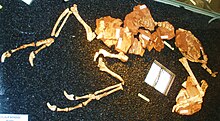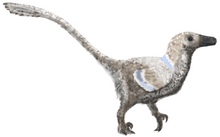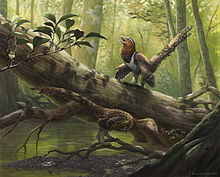Balaur bondoc
| Balaur bondoc | |
|---|---|

| |
| Holotype specimen | |
| Scientific classification | |
| Domain: | Eukaryota |
| Kingdom: | Animalia |
| Phylum: | Chordata |
| Clade: | Dinosauria |
| Clade: | Saurischia |
| Clade: | Theropoda |
| Clade: | Paraves |
| Genus: | †Balaur Csiki et al., 2010 |
| Species: | †B. bondoc
|
| Binomial name | |
| †Balaur bondoc Csiki et al., 2010
| |
Balaur is a
Fossils of Balaur were found in the
Discovery and naming

The first small bones belonging to Balaur bondoc consisted of six elements of the front limbs. Named specimens FGGUB R. 1580–1585, these were discovered in 1997 in
The
Description

Balaur is a
The partial skeleton was collected from the red floodplain


It is similar in size to
Classification

The position of Balaur relative to other bird-like dinosaurs and early birds has been difficult to determine. The initial
More recent analyses using different sets of anatomical data have since cast doubt on a dromaeosaurid classification for Balaur. In 2013, a larger analysis containing a wide variety of coelurosaurs found that Balaur was not a dromaeosaurid at all, but a basal
On the other hand, some recent studies continue to place Balaur within the Velociraptorinae.[19][20]
Paleobiology
Diet and lifestyle

Little is known about the behavior of Balaur. Because of the lack of skull material, it is impossible to determine by the shape of the teeth whether Balaur was a carnivore or a herbivore. The original description assumed it was carnivorous because it had been found that it was closely related to
Italian paleontologist Andrea Cau has speculated that the aberrant features present in Balaur may have been a result of this theropod being omnivorous or herbivorous rather than carnivorous like most non-avian theropods. The lack of the third finger may be a sign of reduced predatory behavior, and the robust first toe could be interpreted as a weight-supporting adaptation rather than a weapon. These characteristics are consistent with the relatively short, stocky limbs and wide, swept-back pubis, which may indicate enlarged intestines for digesting vegetation as well as reduced speed. Cau referred to this as the "Dodoraptor" model.[25] However, in light of the research done by Fowler et al., Cau has remarked that the anatomy of Balaur may be more congruent with the hypothesis that Balaur was predatory after all.[26]
In 2015, Cau et al. reconsidered the ecology of Balaur again in their reevaluation of its phylogenetic position, arguing that if Balaur was an avialan, it would be phylogenetically bracketed by taxa known to have been herbivorous, such as Sapeornis and Jeholornis. This suggests a non-hypercarnivorous lifestyle to be a more parsimonious conclusion and supports Cau's initial interpretations of its specializations. This is also indicated by the reduced third finger, the lack of a ginglymoid lower articulation of the second metatarsal and the rather small and moderately recurved second toe claw. Balaur had a broad pelvis, a broad foot, a large first toe, and broad lower ends of the metatarsals relative to the articulation surfaces; such a combination can in the remainder of the Theropoda only be found with the herbivorous Therizinosauridae.[18]
Island syndrome

During the
.In addition to island syndrome, species isolated on islands are also affected by genetic drift and the founder effect to a greater degree due to the small effective population size. This can magnify the effects of mutations which may otherwise be diluted in a larger population and may have given rise to some of the neomorphisms seen in Balaur like the retractable claw on its first toe.[10]
In 2010, the increased robustness of Balaur was compared to parallel changes seen in isolated herbivorous mammals.[11] In 2013, it was claimed that Balaur was the only predatory vertebrate known to have become more robust after invading an island niche and it was suggested that its broad feet had evolved to improve postural stability.[14] The 2015 interpretation of Balaur as an omnivorous member of the Avialae, suggested it was the descendant of a flying species that had developed a larger size similar to the development in several other island herbivores. This would then be a rare instance of secondary flightlessness in a paravian to resemble a dromaeosaurid, as predicted by Gregory S. Paul.[18]
References
- ^ "Definitie: balaur | DEX online". Dexonline.ro. Retrieved 2010-09-25.
- ^ "Definitie: bondoc | DEX online". Dexonline.ro. Retrieved 2021-03-12.
- .
- ^ S2CID 20356466.
- ^ S2CID 83768608.
- ^ a b "'Stocky dragon' dinosaur terrorized Late Cretaceous Europe". Physorg.com. Archived from the original on 1 September 2010. Retrieved 2010-09-01.
- ^ "Scientists Unveil New and Improved Velociraptor Cousin – Time NewsFeed". Newsfeed.time.com. 2010-08-31. Retrieved 2010-09-01.
- ^ Csiki, Z. & Grigorescu, D. (2005). "A new theropod from Tustea: are there oviraptorosaurs in the Upper Cretaceous of Europe?" (PDF). Kaupia. 14: 78. Archived from the original (PDF) on 2016-03-04. Retrieved 2010-09-26.
- ^ "Balaurul bondoc zguduie lumea științei". Adevărul (in Romanian). August 2010. Archived from the original on 14 September 2010. Retrieved 2010-09-01.
- ^ PMID 20805514.
- ^ PMID 20805514.
- ^ a b c "BBC News – Beefy dino sported fearsome claws". Bbc.co.uk. 2010-08-31. Retrieved 2010-09-01.
- OCLC 985402380.
- ^ S2CID 59932467.
- S2CID 4364892.
- S2CID 37866029.
- S2CID 4464659.
- ^ PMID 26157616.
- S2CID 231597229.
- S2CID 243849373.
- ^ "New Predatory Dinosaur Discovered in Romania". Wired. 2009-01-04. Archived from the original on 2010-08-31. Retrieved 2010-09-01.
- ^ Caroline Davies (2010-08-30). "Frightening new predator found in the homeland of the dragon | Science". The Guardian. London. Archived from the original on 31 August 2010. Retrieved 2010-09-01.
- PMID 22194962.
- ^ Choi, Charles (14 December 2011). "Velociraptors' Killer Claws Helped Them Eat Prey Alive". LiveScience.
- ^ Cau, A (2010). Balaur: More than just a "Double-Sickle-Clawed Raptor" Theropoda, September 1, 2010.
- ^ Cau, A (2011). The Extinction of Dodoraptor (?) Theropoda, December 30, 2011.
- ^ PMID 20435913.
- PMID 32315628.
External links
